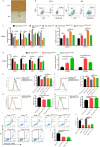Study on the Immune Escape Mechanism of Acute Myeloid Leukemia With DNMT3A Mutation
- PMID: 34093541
- PMCID: PMC8173207
- DOI: 10.3389/fimmu.2021.653030
Study on the Immune Escape Mechanism of Acute Myeloid Leukemia With DNMT3A Mutation
Abstract
DNA (cytosine-5)-methyltransferase 3A (DNMT3A)-mutated acute myeloid leukemia (AML) has a poor prognosis, but the exact mechanism is still unclear. Here, we aimed to explore the mechanism of immune escape in AML with DNMT3A mutation. We constructed a DNMT3A knockout clone and DNMT3A-R882H-mutated clones. RNA-seq results showed that transcription factors and macrophage inflammatory proteins were significantly downregulated in the DNMT3A mutant clones. KEGG enrichment and gene set enrichment analysis (GSEA) showed that a large number of genes were enriched in inflammatory immune-related pathways, such as the toll-like receptor signaling pathway. Therefore, we co-cultured AML cells with macrophages. The DNMT3A-mutated AML cells attenuated M1 macrophage polarization and resisted its killing effect in vitro and in vivo. In xenografts, the tumor volumes in the experimental group were significantly larger than those in the control group, and the proportion of M2 macrophages was significantly higher. After the co-culture, the increase in pro-inflammatory cytokine expression in the mutant cells was significantly lower than that in the control group, while that in immunosuppressive factors was not significantly different. In co-cultivated supernatants, the concentration of inflammatory factors in the experimental group was significantly lower than that in the control group, while that of immunosuppressive factors was significantly higher. Resistin significantly promoted the expression of inflammatory proteins in AML cells. It relieved the inhibitory effect of DNMT3A mutation, promoted the phenotypic recovery of the co-cultured macrophages, eliminated resistance, and regulated the immune microenvironment. Thus, resistin may serve as an ancillary drug for patients with DNMT3A-mutated AML.
Keywords: AML; DNMT3A; epigenetics; immune escape; immune microenvironment; macrophage polarization.
Copyright © 2021 Que, Li, Lin, Zhu, Xiao, Wang, Zhu and Li.
Conflict of interest statement
The authors declare that the research was conducted in the absence of any commercial or financial relationships that could be construed as a potential conflict of interest.
Figures







Similar articles
-
Targeting Calprotectin S100A8/A9 to Overcome AML Progression in DNMT3A-Mutant Cells.Curr Med Sci. 2025 Jun;45(3):458-468. doi: 10.1007/s11596-025-00042-2. Epub 2025 Apr 23. Curr Med Sci. 2025. PMID: 40266434
-
XPO1 inhibition displays anti-leukemia efficacy against DNMT3A-mutant acute myeloid leukemia via downregulating glutathione pathway.Ann Hematol. 2024 Jul;103(7):2311-2322. doi: 10.1007/s00277-024-05706-y. Epub 2024 Mar 23. Ann Hematol. 2024. PMID: 38519605
-
DNMT3A R882H mutation drives daunorubicin resistance in acute myeloid leukemia via regulating NRF2/NQO1 pathway.Cell Commun Signal. 2022 Oct 27;20(1):168. doi: 10.1186/s12964-022-00978-1. Cell Commun Signal. 2022. PMID: 36303144 Free PMC article.
-
DNMT3A in Leukemia.Cold Spring Harb Perspect Med. 2017 Feb 1;7(2):a030320. doi: 10.1101/cshperspect.a030320. Cold Spring Harb Perspect Med. 2017. PMID: 28003281 Free PMC article. Review.
-
Acute myeloid leukemia with DNMT3A mutations.Leuk Lymphoma. 2014 Sep;55(9):2002-12. doi: 10.3109/10428194.2013.869802. Epub 2014 Mar 7. Leuk Lymphoma. 2014. PMID: 24283755 Review.
Cited by
-
Targeting Calprotectin S100A8/A9 to Overcome AML Progression in DNMT3A-Mutant Cells.Curr Med Sci. 2025 Jun;45(3):458-468. doi: 10.1007/s11596-025-00042-2. Epub 2025 Apr 23. Curr Med Sci. 2025. PMID: 40266434
-
Macrophage-Based Therapeutic Strategies in Hematologic Malignancies.Cancers (Basel). 2023 Jul 22;15(14):3722. doi: 10.3390/cancers15143722. Cancers (Basel). 2023. PMID: 37509382 Free PMC article. Review.
-
Demethylating therapy increases cytotoxicity of CD44v6 CAR-T cells against acute myeloid leukemia.Front Immunol. 2023 Apr 27;14:1145441. doi: 10.3389/fimmu.2023.1145441. eCollection 2023. Front Immunol. 2023. PMID: 37180104 Free PMC article.
-
Macrophage migration inhibitory factor blockade reprograms macrophages and disrupts prosurvival signaling in acute myeloid leukemia.Cell Death Discov. 2024 Mar 28;10(1):157. doi: 10.1038/s41420-024-01924-5. Cell Death Discov. 2024. PMID: 38548753 Free PMC article.
-
XPO1 inhibition displays anti-leukemia efficacy against DNMT3A-mutant acute myeloid leukemia via downregulating glutathione pathway.Ann Hematol. 2024 Jul;103(7):2311-2322. doi: 10.1007/s00277-024-05706-y. Epub 2024 Mar 23. Ann Hematol. 2024. PMID: 38519605
References
Publication types
MeSH terms
Substances
LinkOut - more resources
Full Text Sources
Medical

